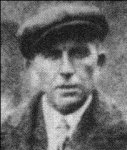Titanic's youngest officer, the faithful James Moody
/James Paul Moody left his home in Scarborough, England to attend King Edward Nautical School in London. He graduated in 1911 at the age of 23, and was hired by the White Star Line to serve aboard the luxurious Oceanic. Less than one year later, he was transferred to the Titanic as her Sixth Officer and sent to Belfast, where Titanic would be fitted out and prepared for her maiden voyage. Excited to be sailing aboard the world’s largest vessel, Moody was well-liked and loved to joke with his fellow crewmen.

Sixth Officer James P. Moody
The Titanic sailed from her home in Belfast to Southampton, where most of her crew was hired. Stewards, stokers, trimmers, cooks, errand boys, lift boys and other crewmembers boarded early on April 10th, prior to passenger arrivals. Six members of the crew, however, stayed too long at the local pub and had to run to catch the ship. When they reached the docks, James Moody had just ordered the gangplank to be pulled aboard. Not wanting to lose their new jobs, the men argued, but Moody refused to let them board. Six others had already been hired in their place.
Moody was responsible for the daily measuring of the air and water temperatures. He also took the 8:00-12:00 am and pm watches, plus the “dog watch” from 4:00-5:00 pm.
At 11:39 pm on the night of April 14th, he was on watch on the bridge with First Officer William Murdoch. Lookout Frederick Fleet phoned the bridge. Moody answered and said, “What do you see?”
Fleet replied, “Iceberg, right ahead!” Moody immediately told Murdoch, who sent an order to the engine room on the telegraph. “Stop! Full speed astern!” followed by orders to turn the ship and close the doors between the watertight compartments. Despite their efforts, the Titanic rammed into the iceberg along its starboard side.
The Titanic Officers, with James Moody seated on the far left
As soon as Captain Smith ordered the lifeboats to be filled and lowered, Moody was sent to help with loading passengers into boats on the port side. When told by Fifth Officer Lowe to go with Boat 14, he refused. Although it was traditional for lower ranking officers to be given the position of manning a lifeboat, Moody told Lowe to take his place. He then went to the starboard side to assist Officer Murdoch.
James Moody was last seen by a ship’s trimmer, working to launch one of the collapsible lifeboats. His body was not recovered. He was 24 years of age.
The memorial plaque below, near his childhood home in Scarborough, is in honor of James Moody. Note the inscription near the bottom, with the Biblical quote from his mother's tombstone: "Greater love hath no man than this; that he lay down his life for his friends." Additional memorials have been erected to remember the sacrifice of Titanic's youngest officer.
photo





